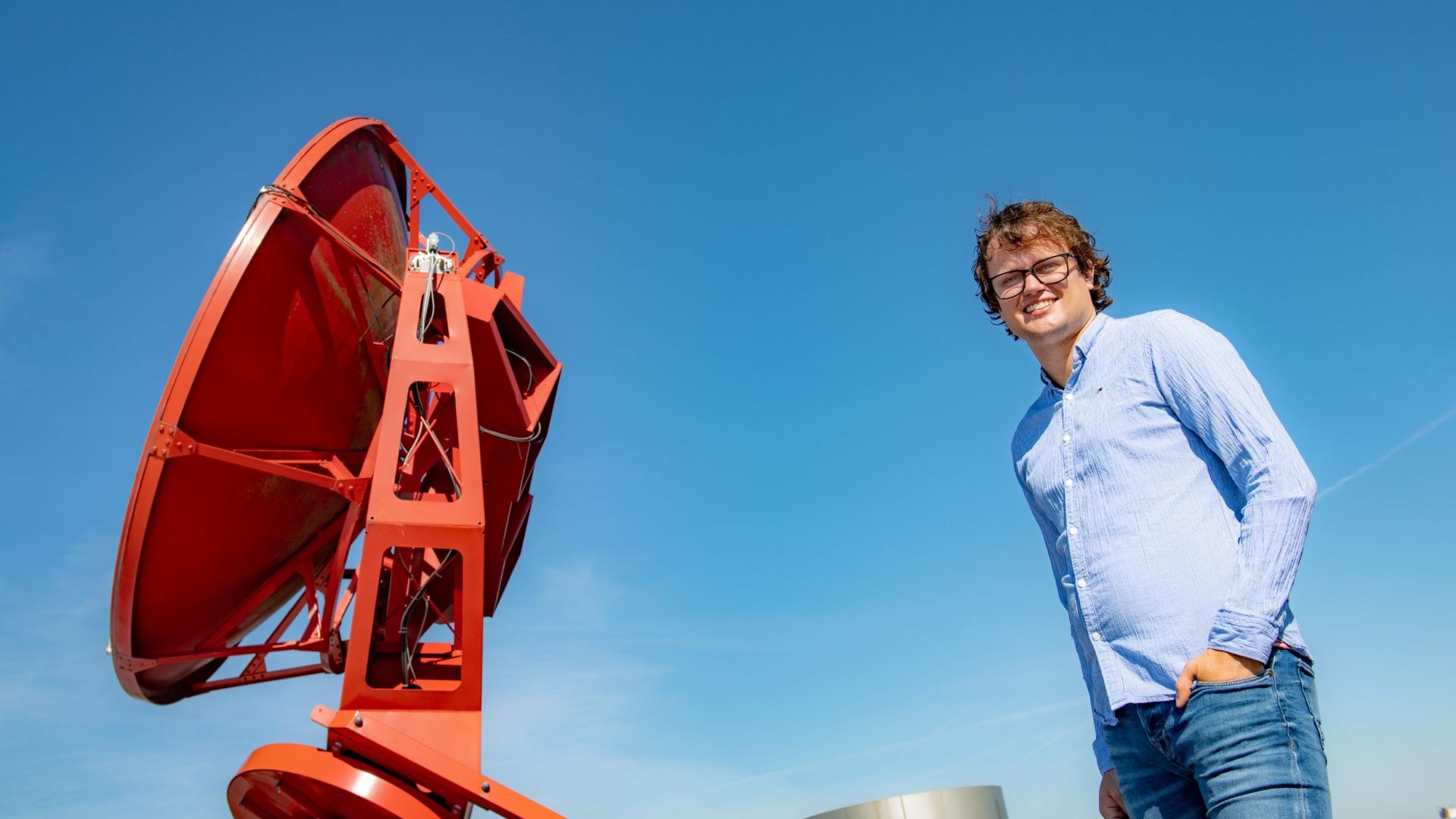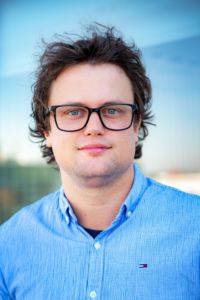‘A photo of a black hole? Einstein could only dream about that’
-
 Jordy Davelaar with a radio telescope on the roof of the Huygens building. Photo: Bert Beelen
Jordy Davelaar with a radio telescope on the roof of the Huygens building. Photo: Bert Beelen
For many scientists it’s an unfulfilled dream: your research on worldwide television and in every newspaper. For astrophysicist Jordy Davelaar, who helped to calculate the black hole that was photographed last year, it became reality even before his dissertation had been finished. Next Monday he’ll be awarded his PhD from Heino Falcke, the figurehead of black holes.
As astronomy PhD candidate Jordy Davelaar has always noticed that a lot of people find the universe fascinating. But this fascination really peaked in April last year with the publication of the first photo of a black hole, M87. As a researcher in the Event Horizon Telescope team (EHT), which took the photo, Davelaar was closely involved in its realisation.
In his office in the Huygens Building, Davelaar talked about the day when news of the photo was made public. At that time, he was in the US for his research. “Shortly after the photo presentation, I was in an Uber heading to Princeton University, and the driver became wildly enthusiastic when he heard that I’d been involved in the photo. ‘Let’s take a longer route’ he exclaimed.”
Now a year later, Davelaar’s work is again attracting interest. The weekly magazine Elsevier recently put him on the list of 30 people younger than 30 whom we should keep an eye on in the next few years. But scientists are also interested in Davelaar: next Monday a group of colleagues will critically examine his dissertation during his PhD ceremony in the Aula in Nijmegen.
Your career started with a bang thanks to that photo. Isn’t your scientific high point already behind you now?
“That photo was, of course, a historic event. You’ll probably experience something that huge only once. But there are still so many unanswered questions. What happens in the centre of a black hole? How can the theory of gravity be combined with quantum mechanics? I can’t imagine that similarly spectacular discoveries won’t be made in the next forty years. For example, there are plans to send new telescopes into space. They’ll enable us to make much more detailed photos of black holes, like Sagittarius A*, in the centre of our Galaxy.”
Are you amazed by all the attention for the photo?
“It’s sometimes said that astronomy has always been a bit of the PR department in physics because it’s so evocative. And the more evocative something is, the easier it is to attract the attention of the general public. But this was extreme; 2019 was an absurd year.”
Is that photo anything more than a PR stunt? It’s 2D, vague and with an extremely low resolution – you said about 20 pixels.
“It’s definitely not a PR stunt. Because of that photo, we know that the general theory of relativity is correct. At least, the photo doesn’t contradict it. And that was still a question since no one had ever photographed a black hole before. If the photo had been very different, Einstein’s theory would have had to be tossed out.”

You made simulations of black holes in your PhD dissertation. What’s the use of those now that we have a real photo?
“The simulations that I’m working on are needed to see if the photo that we took is in line with our knowledge of black holes. For my dissertation I added extra physical effects, such as the acceleration of electrons. This is something that happens at plasma flares around black holes (‘eruptions’ of extremely hot gases in which atom nuclei and electrons move independently of one another, ed.). They can be compared to solar flares that sometime erupt from our own sun. To understand black holes, it’s important to know how electrons behave in those flares. The models that we used (and he raised his voice a bit, ed.) to analyse the photo said very little about that.”
What causes plasma flares?
“The magnetic fields around black holes are extremely strong. Flares occur when opposite magnetic field lines collide (as if you’re pushing the plus poles of two magnets together, ed.) This is called magnetic reconnection, and it releases a lot of energy. That energy is absorbed by plasma particles, which then warm up, accelerate and cause a burst of radiation. We can observe that radiation on earth with telescopes.
The adjusted models in my dissertation, which take account of the consequences of magnetic reconnection, can explain observations better than the old models can. They were based on the assumption that electrons didn’t accelerate but instead remained in equilibrium with one another. But that’s not the case, as we know from measurements of, for example, solar flames. Some electrons receive much more energy, which means they emit radiation more efficiently.”
What does this teach us about black holes?
“This higher efficiency means that less mass is needed to realise a certain radiation effect. And that means that probably less material revolves around black holes like M87 and Sagittarius A* than was previously thought. Perhaps twice as little, I calculated. So to be able to adequately interpret a photo of a black hole, for example, it’s important that we have good simulation models.”
And will it take twice as long before the black hole in the centre of our Galaxy swallows up the Earth?
“No, it’s not that simple. But that won’t happen anyhow because our solar system is too far away from the centre. Before we’re ever swallowed up, the sun will have long since burnt out. That’s more likely to be a problem, haha.”
“I thought I was better than a Nobel Prize winner”
You’ve also made a virtual reality simulation of what it looks like around a black hole. Why?
“It’s a form of public outreach, which I think is important. On the days that it is open to the public it makes children extremely enthusiastic about astronomy. But it’s also useful scientifically. A perspective ‘from the inside’ helps you to understand what happens in a black hole better than when you look at a two-dimensional photo taken from the Earth. The moon also looks completely different if you put a camera on its surface instead of looking at it through a telescope.”
In the science fiction film Interstellar, we also see a simulation of a black hole. Hollywood spent millions on that, but scientists sometimes have to scrape together their funding. Is that frustrating?
“No. The funny thing is that that film was one of the incentives for me to make a VR simulation. Astrophysicists, including the American Nobel Prize winner Kip Thorne, worked on Interstellar. They even published an article about it in a journal, so it also had a scientific spinoff. But they adjusted their simulation for the film, and, as I once said to NBC (an American broadcaster, ed.), I wanted to do it better. They immediately wrote that I thought I was better than a Nobel Prize winner, haha.”
What will you do after you get your PhD? You’re doing top research, you’re on Elsevier’s list, it seems that only the sky’s the limit, literally and figuratively.
“I’m going to continue my research at Columbia University and the Flatiron Institute. That’s really the top in the area of astroplasma research. I’m starting on 1 October, and I’ve just heard that I have been granted a visa. That’s a huge relief because the American corona travel ban made things tense for a while.
I was just very lucky with respect to my PhD research. The timing was perfect when I started in 2016. Preparations had just begun for the EHT to take a photo of the black hole. A hundred years ago, Einstein could only have dreamt about that.”



